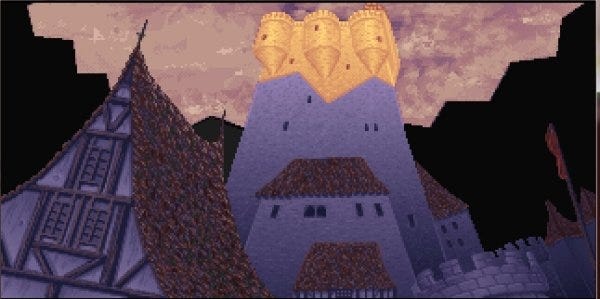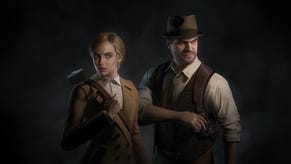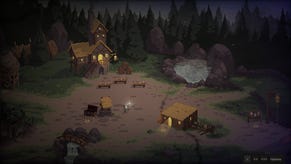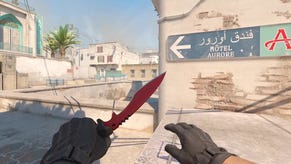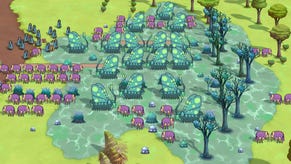Mnemotechnics And Ultima Underworld II
This isn't like other Ultima Underworld II retrospectives. This is Dan Griliopoulos' account of Ultima Underworld II as a "memory palace", a mental construct which Wikipedia describes as a "mnemonic technique that relies on memorised spatial relationships to establish, order and recollect memorial content." That's the starting point. Let's find out what he's up to in there.
Let me start in the middle; I own a palace.
My palace is strange. I mean, it's really strange. I've owned it since 1990, which is over twenty years now. Bits of it are in disrepair, tattered, cobwebbed fragments of texture and space, but much of it's intact and strangely ageless. The way in, for me, is a tiny room in the North-West corner. This room is a comfortable home-from-home, built like a sauna with wood on the floor and walls, a roaring fire, a stacked bookshelf, some food and beer on the table. There's a secret door behind the bookshelf. Behind that door are some small runes on a table, some drinks, another secret door, and my most precious memories. They're the only ones I'm not going to tell you about.

You knew this from the beginning but my keep is no physical palace. It's a Memory Palace, a mental construct used before computers or even printing. Mine is based on the first floor of Lord British's castle from Ultima Underworld II: Labyrinth of Worlds, a game that was the peak of the Western RPG before Morrowind. In UUII, you play the Avatar, a hero trapped in a castle whilst an enemy invades his world, and who must explore the maze of the basements to find the way out. Consider this, then, a retrospective about the sadly-defunct Ultima series, a discussion of an archaic psychological technique used by mystics since the dawn of time but curiously in abeyance during the modern era, and a pyx about the potential for the things we call games to become more than the structural limitations of engine design.
Mentors
Turn left out of my room, and you're in Iolo's chamber. He's an old crossbow-wielding comrade, a mentor figure to the Avatar who's stayed in Britannia since Ultima 1 and hence has aged much more rapidly than your friend. He was crudely depicted in the early games but he's grown up as the series has gone on, until he's key to the plot of Ultima 7 and 9. He reminds me of older friends and archery, oddly enough, but I don't have that many memories that fit that, save for really good tutors- smelly Mr Hurst, who taught Latin and Greek, or Dr Walker, who gave us all snuff and sherry while he tried to teach us about Kant.
Memory Palaces are imaginary devices used to retain and structure memories. They're also known as the Method of Loci. Essentially, they're a way of using man's over-developed spatial awareness and memory for locations as an aide memoire - you find a location that you know intimately, and lock to it important memories. It's a bit like the tricks those chaps who memorise long strings of numbers do, but developed for the long-term retention of ideas as opposed to the short-term. However, I, in my youth, completely misappropriated it - you're meant to use it for important facts, chunks of text and maths, and so on - using it for memories isn't normal. I did it because I thought it sounded amazing, because I couldn't sleep at nights and because my non-visual memory was awful. I used UUII because I knew it better than any real world location.
Booze
Down the corridor is a t-junction, with a door opposite. Inside is the warrior Dupre, another old companion, along with enough crates of beer to fill a brewery. This isn't suspicious forethought on Dupre's part, just a reflection of his alcoholism - he was first encountered in Ultima III in a pub where he could only say "drink up!" and throughout the series he was trekking over the increasingly-large Britannia "testing beer" for Brommer's Britannia, a guide book a bit like a fantasy Les Routiers. Hence this room is a reflection for me of every time I've been pissed - and as a Brit, this room is chockablock with memories. I remember a few sneaky cans of beer on my last day of school, dancing home when Man Utd came back to win the European Cup, finding a friend passed out in the corridor and helping them home, praying to the ivory throne on so many occasions they've blended into one, passing out in my gown and mortarboard on a posh lawn two hours after my final exam, and many other occasions. Drinking, drinking, drinking.

The art of memory is the science of mnemotechnics. The method of loci isn't the only traditional method for preserving memories, just the only one my ten-year old self had heard of. There isn't any hard evidence as to where it was first used, though ancient Egyptians and Pythagoreans are the usual suspects. Francis Yates, 1960s occult and neoplatonist writer extraordinaire, wrote that "the most common account of the creation of the art of memory centers around the story of Simonides of Ceos, a famous Greek poet, who was invited to chant a lyric poem in honor of his host, a nobleman of Thessaly. While praising his host, Simonides also mentioned the twin gods Castor and Pollux. When the recital was complete, the nobleman selfishly told Simonides that he would only pay him half of the agreed upon payment for the panegyric, and that he would have to get the balance of the payment from the two gods he had mentioned. A short time later, Simonides was told that two men were waiting for him outside. He left to meet the visitors but could find no one. Then, while he was outside the banquet hall, it collapsed, crushing everyone within. The bodies were so disfigured that they could not be identified for proper burial. But, Simonides was able to remember where each of the guests had been sitting at the table, and so was able to identify them for burial. This experience suggested to Simonides the principles which were to become central to the later development of the art he reputedly invented." This sounds like utter nonsense, but it's a good story, and was reason enough for Middle Ages monks to use Simonides' model.
The Library
I first found out about Memory Palaces from Umberto Eco, and his books are amongst the many I keep in Nystul's library, way over on the other side of the Great Hall. Nystul is one of the two Beardy Men in Castle British, the other being the doomed sage Nelson. Nystul is also a powerful wizard and the spitting image of Sean Connery in The Name of the Rose, the origin of the Memory Palace idea in the first place. My memory is hazy here, so this place is oddly murky and badly imagined - there are bits of the parallel worlds you visit later in the game intermingled here, Killorn Keep and the haunting Scintilius Academy. All favourite books are here - Calvino's If On a Winter's Night A Traveller, Le Guin's The Dispossessed, Eco's The Name of the Rose, Borges' Labyrinths, etc.

Where did the Underworld games come from? Older readers, and those who've been messing around with DOSbox, will remind there was a profusion of 2D first-person dungeon-crawlers, like the classic Wizardry, back around when most of us were being born. Amongst these was the precursor to the Ultima series 'Akalabeth: World of Doom' (1979), made by the teenage Richard Garriott for the Apple II (and parodied in one of the levels of UUII). Though monochrome and line-based, Akalabeth featured the basics of most RPGS, Eastern and Western - underground first-person dungeons and a top-down map. If we're to refer to Malcolm Gladwell's Outliers theory, Garriott had a full 10 years of developing first-person roleplaying games, giving him a tremendous advantage in knowing what worked, what was easy and what was currently impossible when it came to making the Underworld games. That kept the Ultima series at the front of the pack until everyone else caught up - sadly, Garriot's recent track-record indicates he wasn't able to convert that head-start into a long-term advantage.
Love and Hate
Turn right past Dupre's boozatorium, and you find the guest quarters - featuring Patterson, the Mayor, who (SPOILER) is a repeated traitor, loyal to the avatar's worst enemy. Here I used to remember conmen or slimy people, like a short kid called Daniel who conned me out of my entire stack of World Cup 90 Panini swaps when I was 9 and who's probably a lawyer now. In my head, his room is the equivalent of the Great Book of Grudges. Around the corner is Feridwyn - an innocent orphanage keeper who you can repeatedly accuse of being a traitor, and whose room houses my regrets - which I'm not going into.
Julia The Tinker and Lady Tory are also round the corner; two clever and passionate women living next to each other. Julia has been a tinker for over 200 years, though she doesn't seem sure it's the right job for her and she seems to have had a facelift since Ultima VI. She's something of a love interest for the avatar so this room is where I keep all memories of, ahem, you know. Don't worry, I'm not going to go all Kieron on you here and turn this into a tell-all of every relationship and this room is a mess of first-kisses and other icky stuff, so let's move on quick.

The Ultima games weren't intended to be just first-person RPGs though. The Akalabeth dual-level style had continued throughout the Ultimas but whilst developing Ultima 6 (1988) it was decided to drop their nascent 3D dungeon-crawling engine from production, as at that stage they could only do physics in 2D (or isometric 3D), and spin it off into its own series. At this stage the Ultima series divides into two, with Ultima 7, 7 1/2: Serpent Isle and 8: Pagan sticking with the isometric viewpoint that had come from the map levels, and the Underworld games plumbing the dungeons' 3D depths, before reunifying for the awful unplayable mish-mash that was Ultima 9.
Where did the Underworlds lead to? Underworld I: The (apocalyptic, tough) Stygian Abyss was released in 1992, two years before Doom, two months before Wolfenstein 3D's release, and managed true 3D with real-world physics four years before Duke Nukem 3D tried to make a frankly rubbish spiral staircase seem cutting edge. Of course, System Shock was built with the same engine, to take advantage of the sudden success of the FPS genre that had been. Only Underworld-tribute Arx Fatalis and Oblivion since have managed to get near Underworld's achievement - and Arx was crippled by bugs whilst Oblivion was undermined by Bethesda's decision to make the plot secondary to the world. That said, the obvious heirs are the Bioshock games, taking both the rich scripting, exciting action, and RPG elements.
The Rest
Lord British's rooms are unusual in that they're on their own floor and feature a treasure chest you have to cheat to break into; I associate them with both comfort and authority, like lying down in a mid-Winter blizzard on a mountaintop in Flims or when I was sent to the Rabbi's office for blasphemy. The great hall with its (for the time) amazing stained glass windows, represents ceremonies, funerals and weddings. The dining hall was always packed so represented gigs and festivals. The servants quarters has no association for me and the secret passages riddling the outside of the castle are plain empty.
I stopped adding substantially to my memory palace maybe ten years ago. It's not that there's not lots of room to expand; Underworld II was subtitled "Labyrinth of Worlds" and featured eight other heart-breakingly strange and well-designed worlds that you had to visit, where I could have crammed in memories; no, it was just that I didn't find myself with the time to retreat there for several years, ironically generating memories that I didn't store and now have mostly lost.
In fact, this is where UU2 trumps even Planescape: Torment a little - you never feel forced to explore these worlds, you're desperate to visit them because of the well-written descriptions and they're all essential to the plot, not like the somewhat odd wandering at the end of Planescape. There's Killorn Keep, a floating parallel to your world which the Guardian conquered years before; the desolation of the Scintillus Wizard Academy, where your hunt for survivors presages System Shock; the frozen city that has one hallucinating survivor, who you later meet in a dream world; the bizarre programmable alien world of Talorz with its floating organic robot donut things; and the sad, sad Tomb of the defeated hero Praecor Loth.
The Ruins
How does a palace fall? Normally either by siege without or betrayal within; mine fell by both storm and strife, but the starting factor was... distraction. In times of peace and happiness, I left off the palace and didn’t visit. Many of the important memories remained, but others vanished, details faded, significance forgotten and the rotten hearts falling out of the stories. Despite this rot , it lasted until recently, and I could bring up the rooms at will.
The final dissolution, however, was heartbreak. A traumatising end to a beautiful relationship, meant for a time that all attempts at recollection bounced back off the lost object of my affection. Previously, I’d slotted ex-girlfriends in amongst the doomed empath Lady Tory and the avatar’s old friend Julia - but these new memories didn’t need storage, they were strong and intrusive by themselves. It’s hard to maintain a memory palace at the best of times; much harder when every memory triggers an involuntary painful recollection of a lost love, overriding, eroding and breaking hard-made associations. I am rebuilding it, slowly, but it’s no longer a working palace; rather it’s an artefact, a memory of the memories I once held dear.
Before its untimely demise at the hands of EA, Ultima had a fair claim to be the world's number 1 RPG series. Yet, after the disaster of Ultima 9 and the defection of the key members of both the Origin and the Looking Glass teams, EA seems to have decided that the Ultima franchise can be allowed to die when the still-profitable Ultima Online finally karks it. Likewise, before personal computers, the method of loci was the premier amidst many memory techniques mankind used to fix precious ideas in our heads, trumping books for ease of access and permanence of storage. Both Ultima and The Method are now, effectively dead. The key reason both of these memes failed to propagate was a lack of care on the parts of their curators, combined with duplication of function. Mmenotechnics has been made obsolete by other sources of instant, on-demand information, specifically the internet and always-on mobile phones. No-one needs specialist knowledge any more, just a knowledge of the best methods for searching for your particular information. Even basic memory needs have weakened - how many of us know all our families phone numbers any more? If/when the internet falls over (and it will) we're all going to be screwed. Meanwhile, EverQuest, World of Warcraft and Oblivion have undermined the need for Ultima.
If you want to play Ultima Underworld II, you can download it here. You'll need Dosbox to run it.The excellent music is also available on Abandonia Frequency.
When I say 'Ultima Underworld II made me who I am today' I mean, it really did. I've not really talked about the game itself here, but it is a classic of pared-down storytelling and delightful secrets, just inaccessible due to its crude interface and graphics, which once upon a time were revolutionary. It shaped who I am and it let me retain it in the face of a catastrophically bad memory. That's not something I'm ever going to forget.
